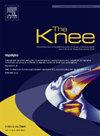半月板挤压和下肢对齐可以预测膝关节软骨下骨密度的分布
IF 2
4区 医学
Q3 ORTHOPEDICS
引用次数: 0
摘要
应力分布是机械载荷分布的模式,特别是在内侧和外侧隔室之间。下肢对齐和半月板在这种分布中起重要作用。ct -骨吸收测定法通过分析软骨下骨密度的分布模式来估计应力分布。本研究旨在探讨下肢排列和半月板挤压在多大程度上解释软骨下骨密度的分布。方法对92例患者进行回顾性研究,其中骨关节炎73例,非骨关节炎19例。使用ct骨吸收仪评估下肢直线、半月板挤压比(MER)和软骨下骨密度。定量分析关节面高密度区(HDA)。结果髋关节-膝踝(HKA)角、内侧MER (MMER)、外侧MER (LMER)和内侧室HDA与总HDA之比(medial ratio)分别为- 4.3°、46.8%、20.4%和70.0%。多元回归分析显示HKA、MMER和LMER为显著变量。HKA、MMER和LMER对中间比值的校正R2为0.80。HKA、MMER和LMER的标准化系数分别为- 0.30、0.40和- 0.41。结论较慢的下肢直线和半月板挤压解释了80%的软骨下骨密度分布差异。这些发现表明,这两个因素可以解释通过ct -骨吸收仪评估的估计应力分布的大约80%。利用HKA和半月板挤压法测定软骨下骨密度分布对膝关节骨性关节炎的诊断和治疗有重要意义。本文章由计算机程序翻译,如有差异,请以英文原文为准。
Meniscus extrusion and lower leg alignment predict the distribution of subchondral bone density across the knee joint
Background
Stress distribution is the pattern of mechanical load distribution, particularly between the medial and lateral compartments. Lower leg alignment and the meniscus play an important role in this distribution. CT-osteoabsorptiometry estimates stress distribution by analyzing the distribution pattern of subchondral bone density. This study aimed to explore the extent to which lower limb alignment and meniscal extrusion can explain the distribution of subchondral bone density.
Methods
This was a retrospective study including 92 patients (73 with osteoarthritis (OA) and 19 without OA). Lower limb alignment, meniscus-extrusion ratio (MER), and subchondral bone density were assessed using CT-osteoabsorptiometry. High-density areas (HDA) on the articular surface were quantitatively analyzed.
Results
Hip-knee-ankle (HKA) angle, medial MER (MMER), lateral MER (LMER), and medial compartment HDA to total HDA ratio (medial ratio) were −4.3°, 46.8 %, 20.4 %, and 70.0 %, respectively. Multiple regression analysis revealed that HKA, MMER, and LMER were significant variables. The adjusted R2 of HKA, MMER, and LMER for the medial ratio was 0.80. The standardized coefficients for HKA, MMER, and LMER were −0.30, 0.40, and −0.41, respectively.
Conclusions
Lower leg alignment and meniscus extrusion explain 80% of the variance in the distribution of subchondral bone density. These findings indicate that both factors can account for approximately 80% of the estimated stress distribution as assessed by CT-osteoabsorptiometry. The distribution of subchondral bone density estimated by HKA and meniscus extrusion was useful for diagnosing and treating knee osteoarthritis.
求助全文
通过发布文献求助,成功后即可免费获取论文全文。
去求助
来源期刊

Knee
医学-外科
CiteScore
3.80
自引率
5.30%
发文量
171
审稿时长
6 months
期刊介绍:
The Knee is an international journal publishing studies on the clinical treatment and fundamental biomechanical characteristics of this joint. The aim of the journal is to provide a vehicle relevant to surgeons, biomedical engineers, imaging specialists, materials scientists, rehabilitation personnel and all those with an interest in the knee.
The topics covered include, but are not limited to:
• Anatomy, physiology, morphology and biochemistry;
• Biomechanical studies;
• Advances in the development of prosthetic, orthotic and augmentation devices;
• Imaging and diagnostic techniques;
• Pathology;
• Trauma;
• Surgery;
• Rehabilitation.
 求助内容:
求助内容: 应助结果提醒方式:
应助结果提醒方式:


